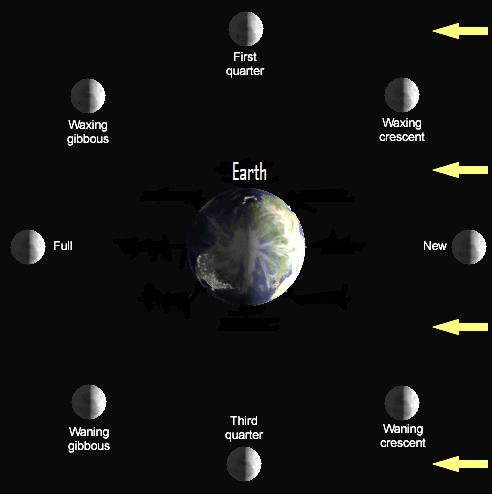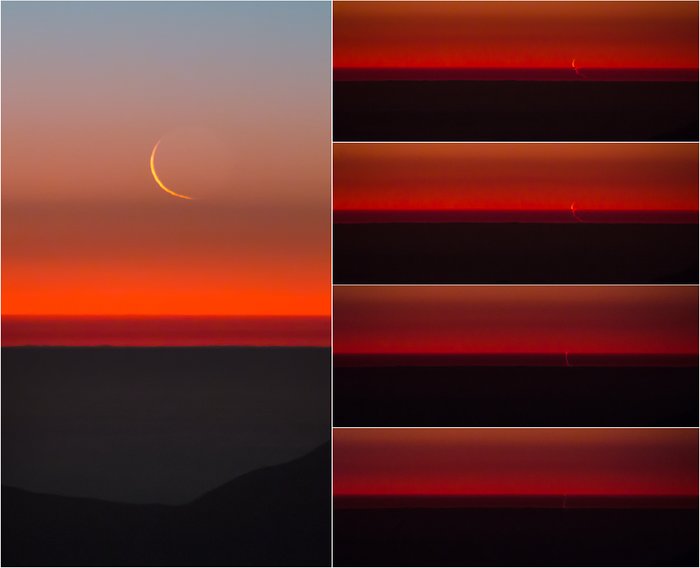
The coming evenings – February 24, 25, 26 and 27, 2020 – present a grand time to go young moon hunting. The moon was new on February 23. On that date, the moon was passing more or less between the Earth and sun for this month and so was moving across our daytime sky – invisibly, all day – in the sun’s glare. But now the moon has moved a touch east of the sun, as seen from Earth. That means it’s a touch east of the sunset, or very low in the west after sunset on February 24 … and higher in the west after sunset each evening after that.
On February 24, the whisker-thin crescent moon might – or might not – fleetingly show itself in the western evening dusk after sundown. Assuming an unobstructed horizon and clear sky, residents of the Americas have a reasonably good chance at spotting the slender smiling crescent on February 24. The moon will set an hour (or more) after sunset on February 24, for us in North America. So you might or might not see the moon on February 24, but you’ll surely see it every evening after that.
And you’ll surely see the planet Venus every evening in the west after sunset. This world ranks as the third-brightest celestial object to light the sky, after the sun and moon. After sunset on February 24, Venus will likely come into view for you before the skinny and pale crescent moon does.
People with good vision may catch Venus as soon as 15 minutes after sundown. If you spot Venus first, then look for the thin crescent beneath Venus, and near the sunset point on the horizon. Binoculars will be helpful!

Peter Lowenstein in Mutare, Zimbabwe, caught the young moon, with its dark side all aglow in earthshine, after sunset September 29, 2019. Notice that this very thin crescent moon – similar to the moon you’ll see on February 24, 2020 – is set against a bright twilight sky.
Each evening after February 24 – as the moon moves eastward in its orbit, and away from the sun on our sky’s dome – the young moon will appear higher in the west after sunset. Watch for earthshine to illuminate the darkened portion of the lunar crescent, as beautifully displayed in the photo above.
Want to know when the sun and moon set in your sky? Visit the sunrise and sunset calculator at the Old Farmer’s Almanac if you live in the U.S. or Canada, or visit Sunrise Sunset Calendars for virtually anyplace worldwide (but remember to check the moonrise and moonset box).
Beginning on February 25, it’ll be fun to watch the young moon move up past Venus in the west after sunset. Try watching at the same time each evening. Note that the moon will appear nearer and nearer to Venus, and then it’ll sweep past Venus. This daily change happens because the moon in its orbit is moving eastward, away from the sunset direction. Watch for the moon to pair up with Venus on or near February 27, 2020.
When the moon finally reaches its first quarter phase on March 2, 2020, then the sun, our planet Earth and the moon will be making a right angle in space, with the Earth at the vertex of this angle. At the time of first quarter moon, the wider angle between the moon and sun prompts the moon to stay out until late night, or around the midnight hour!

Moon’s orbit around Earth, seen from above (north of the ecliptic). The yellow arrows indicate the direction of incoming sunlight. The moon is now in a waxing crescent phase, between new moon and first quarter. Read more: 4 keys to understanding moon phases.
At present, the sun-Earth-moon angle is very acute (small), so the thin waxing crescent sets soon after sunset. If you miss the lunar crescent after sunset February 24, try again on February 25, 26 and 27. Day by day, the moon will appear higher up at sundown, and will display a wider crescent that’ll set later after dark.

View larger. | The dry Atacama Desert might seem like an odd place for the moon to take a dip, but – in this intriguing image, taken by ESO Photo Ambassador Petr Horálek – it appears to do just that. Initially high, the crescent moon slowly descends through the clear Chilean sky, before hitting the thickest parts of the atmosphere right above the horizon. Image via European Southern Observatory.
Bottom line: Bring the kids along with you on February 24, 2020, for their young eyes may well catch the thin lunar crescent before your older eyes do. On February 25, 26 and 27, the moon will be easily visible to all, moving up past bright Venus in the west after sunset.
from EarthSky https://ift.tt/32nKML5

The coming evenings – February 24, 25, 26 and 27, 2020 – present a grand time to go young moon hunting. The moon was new on February 23. On that date, the moon was passing more or less between the Earth and sun for this month and so was moving across our daytime sky – invisibly, all day – in the sun’s glare. But now the moon has moved a touch east of the sun, as seen from Earth. That means it’s a touch east of the sunset, or very low in the west after sunset on February 24 … and higher in the west after sunset each evening after that.
On February 24, the whisker-thin crescent moon might – or might not – fleetingly show itself in the western evening dusk after sundown. Assuming an unobstructed horizon and clear sky, residents of the Americas have a reasonably good chance at spotting the slender smiling crescent on February 24. The moon will set an hour (or more) after sunset on February 24, for us in North America. So you might or might not see the moon on February 24, but you’ll surely see it every evening after that.
And you’ll surely see the planet Venus every evening in the west after sunset. This world ranks as the third-brightest celestial object to light the sky, after the sun and moon. After sunset on February 24, Venus will likely come into view for you before the skinny and pale crescent moon does.
People with good vision may catch Venus as soon as 15 minutes after sundown. If you spot Venus first, then look for the thin crescent beneath Venus, and near the sunset point on the horizon. Binoculars will be helpful!

Peter Lowenstein in Mutare, Zimbabwe, caught the young moon, with its dark side all aglow in earthshine, after sunset September 29, 2019. Notice that this very thin crescent moon – similar to the moon you’ll see on February 24, 2020 – is set against a bright twilight sky.
Each evening after February 24 – as the moon moves eastward in its orbit, and away from the sun on our sky’s dome – the young moon will appear higher in the west after sunset. Watch for earthshine to illuminate the darkened portion of the lunar crescent, as beautifully displayed in the photo above.
Want to know when the sun and moon set in your sky? Visit the sunrise and sunset calculator at the Old Farmer’s Almanac if you live in the U.S. or Canada, or visit Sunrise Sunset Calendars for virtually anyplace worldwide (but remember to check the moonrise and moonset box).
Beginning on February 25, it’ll be fun to watch the young moon move up past Venus in the west after sunset. Try watching at the same time each evening. Note that the moon will appear nearer and nearer to Venus, and then it’ll sweep past Venus. This daily change happens because the moon in its orbit is moving eastward, away from the sunset direction. Watch for the moon to pair up with Venus on or near February 27, 2020.
When the moon finally reaches its first quarter phase on March 2, 2020, then the sun, our planet Earth and the moon will be making a right angle in space, with the Earth at the vertex of this angle. At the time of first quarter moon, the wider angle between the moon and sun prompts the moon to stay out until late night, or around the midnight hour!

Moon’s orbit around Earth, seen from above (north of the ecliptic). The yellow arrows indicate the direction of incoming sunlight. The moon is now in a waxing crescent phase, between new moon and first quarter. Read more: 4 keys to understanding moon phases.
At present, the sun-Earth-moon angle is very acute (small), so the thin waxing crescent sets soon after sunset. If you miss the lunar crescent after sunset February 24, try again on February 25, 26 and 27. Day by day, the moon will appear higher up at sundown, and will display a wider crescent that’ll set later after dark.

View larger. | The dry Atacama Desert might seem like an odd place for the moon to take a dip, but – in this intriguing image, taken by ESO Photo Ambassador Petr Horálek – it appears to do just that. Initially high, the crescent moon slowly descends through the clear Chilean sky, before hitting the thickest parts of the atmosphere right above the horizon. Image via European Southern Observatory.
Bottom line: Bring the kids along with you on February 24, 2020, for their young eyes may well catch the thin lunar crescent before your older eyes do. On February 25, 26 and 27, the moon will be easily visible to all, moving up past bright Venus in the west after sunset.
from EarthSky https://ift.tt/32nKML5

Aucun commentaire:
Enregistrer un commentaire